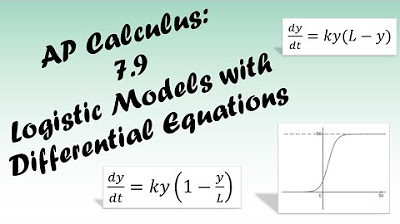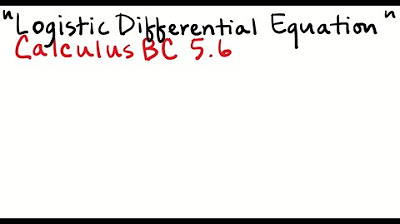This is why you're learning differential equations
TLDRThis video explores the significance of differential equations in understanding various real-world phenomena. It delves into how these equations model population growth, fluid dynamics, electromagnetism, and the motion of objects in pursuit. The video also discusses the application of differential equations in diverse scenarios, from the gym equipment with hanging chains to the spread of infectious diseases like COVID-19, emphasizing their critical role in predicting and analyzing complex systems.
Takeaways
- 📚 Differential equations are crucial for describing how nature and the universe work, despite their complexity.
- 🌿 Population growth models, fluid dynamics, electromagnetism, and even the motion of orbiting bodies are all described using differential equations.
- 🎯 The pursuit curve is a real-world application of differential equations, used to predict the paths of moving objects, such as in law enforcement tracking.
- 🚀 The motion of objects with changing mass, like a rocket losing mass as it exhausts, leads to differential equations that are essential for understanding and designing such systems.
- 🏋️♂️ Even everyday exercises like bench presses and squats with chains can be analyzed using differential equations to understand the changing forces involved.
- 📈 The spread of infectious diseases, such as COVID-19, is modeled using differential equations, which help predict and manage outbreaks.
- 🔄 The interactions between populations, like bacteria and phages, are dynamic and can be understood through differential equations that describe their growth and decline.
- 🌐 Differential equations have a wide range of applications, from the behavior of electrical circuits to the modeling of waves and the analysis of structural beams.
- 📊 Tools like phase portraits can help visualize the behavior of systems described by differential equations without needing to find exact solutions.
- 🎓 Learning differential equations can be beneficial for students and professionals alike, offering insights into a variety of real-world phenomena and challenges.
- 🔗 Online platforms like Brilliant offer courses that delve into the practical applications of differential equations, making them accessible for further learning and exploration.
Q & A
Why are differential equations important in understanding the natural world?
-Differential equations are crucial because they describe how nature works and the universe functions. They are used to model a wide range of phenomena, from population growth to fluid dynamics, electromagnetism, and more.
What is a pursuit curve and how does it relate to real-world situations?
-A pursuit curve is the path traced by one object chasing another. It has real-world applications such as predicting the movements of criminals in law enforcement, missile guidance systems, and aircraft navigation.
How does the concept of a pursuit curve apply to the TV show 'Numbers'?
-In 'Numbers', the FBI uses pursuit curves to analyze the movement patterns of criminals across the United States, hoping to predict their future actions based on their past trajectories.
What are the assumptions made when determining the curve of a pursuing object?
-The assumptions include that the pursued object has a predetermined path and that the pursuer always faces the direction of the pursued object, adjusting its orientation as needed during the chase.
How does the motion of lifting a chain with a barbell involve differential equations?
-The motion involves a second-order nonlinear differential equation because the mass of the chain changes as it is lifted, affecting the force required to lift it. This system is complex and requires advanced mathematical modeling.
What is the SI model in the context of infectious diseases?
-The SI model is a basic epidemiological model that divides the population into two categories: susceptible (S) and infected (I). It helps to understand how an infection spreads through a population.
How does the rate of change of susceptible and infected populations affect the spread of a disease?
-The rate of change for susceptible individuals is negative, as they transition to infected. For infected individuals, the rate of change starts positive and then becomes negative as they recover or die, reducing the spread of the disease.
What is the significance of phase portraits in studying differential equations?
-Phase portraits provide a visual representation of the solutions to a system of differential equations, allowing us to understand the dynamics of a system without finding an exact solution. They can reveal equilibrium points and long-term behavior.
How does the population growth model change when considering interactions between two populations, such as bacteria and phages?
-The model becomes more complex, with the growth rates of the populations depending on each other. For example, phages grow when feeding on bacteria, but their population declines if bacteria are scarce, leading to a cyclical interaction described by differential equations.
What resources are available for those interested in learning more about differential equations and their applications?
-Brilliant.org offers courses on differential equations, including real-world applications like pursuit curves, wave equations, and models for beams. These courses cater to various levels of education, from beginners to those seeking advanced knowledge.
Outlines
📚 Learning Differential Equations: Nature's Language
This paragraph introduces the importance of learning differential equations as they are the mathematical tools used to describe how nature works. It emphasizes the ubiquity of these equations in various fields such as modeling population growth, fluid dynamics, electromagnetism, and more. The paragraph also presents a real-world scenario where differential equations are used to solve a problem related to the area under a curve versus the arc length, showcasing their practical applications and the insights they can provide.
🚀 Pursuit Curves and Real-World Applications
The second paragraph delves into the concept of pursuit curves, which describe the path of one object chasing another. It uses the example of a TV show 'Numbers' to illustrate how the FBI uses these curves to predict the movements of criminals. The paragraph explains the assumptions made in such scenarios and the process of deriving the differential equation that governs the motion of the pursuing object. It also touches on how pursuit curves can be applied to various real-world situations like missile guidance systems and aircraft navigation.
🏋️♂️ The Complex Motion of a Bench Press with Chains
This paragraph explores a more casual application of differential equations by examining the motion of a barbell with chains during a bench press or squat. It discusses how the changing weight of the chains as they are lifted complicates the motion and leads to a second-order nonlinear differential equation. The paragraph highlights the complexity of analyzing systems with changing mass, using the example of a rocket losing mass as it burns fuel, and emphasizes the broader applicability of these mathematical concepts.
🦠 Modeling Infectious Disease Spread with Differential Equations
The final paragraph discusses the use of differential equations in modeling the spread of infectious diseases, specifically using the example of the coronavirus pandemic. It explains the Susceptible-Infected-Recovered (SIR) model and how it uses differential equations to represent the rate of change in the number of people in each category. The paragraph also touches on the impact of social distancing and other factors on the rate of infection and recovery, and how these models help in understanding and predicting the spread of diseases.
Mindmap
Keywords
💡Differential Equations
💡Nature
💡Maxwell's Equations
💡Pursuit Curves
💡Changing Mass
💡Epidemiology
💡Population Dynamics
💡Phase Portraits
💡Brilliant
💡Real-World Applications
Highlights
Differential equations are essential for describing how nature works and the universe operates.
Despite their difficulty, solving differential equations can yield valuable insights into various scientific and real-world phenomena.
Modeling population growth involves the use of differential equations to predict changes over time.
Fluid dynamics, the study of how fluids move, is described using differential equations.
Maxwell's equations, a set of four differential equations, are fundamental to understanding electromagnetism and technologies like phones, radio, Wi-Fi, and GPS.
Differential equations can represent meaningful relationships, such as the age difference between siblings, using algebraic equations.
The pursuit curve is a practical application of differential equations, used to model the trajectory of one object chasing another, such as in wildlife or aerial pursuits.
In the TV show 'Numbers', pursuit curves are used to predict the movements of criminals, illustrating the real-world application of mathematical models.
The motion of lifting a barbell with chains can be described by a second-order nonlinear differential equation, demonstrating the complexity of seemingly simple physical activities.
Rockets, like the barbell with chains, involve changing mass, which leads to differential equations that account for the loss of mass as fuel is expended.
The spread of infectious diseases, such as the coronavirus, can be modeled and predicted using systems of differential equations, providing insight into public health crises.
The SIR model (Susceptible, Infected, Recovered) is a fundamental epidemiological model that uses differential equations to track the spread of diseases within a population.
Population dynamics, including growth and interaction between different species, can be complexly modeled using differential equations, as seen in the predator-prey relationships of bacteria and phages.
Phase portraits are a tool used to visualize the behavior of systems described by differential equations without necessarily finding an exact solution.
Brilliant.org offers courses on differential equations that focus on real-world applications, including pursuit curves, wave equations, and the behavior of beams.
For those interested in deepening their understanding of differential equations, Brilliant.org provides a platform to learn, regardless of educational level, with courses starting from the basics to more advanced topics.
The video encourages viewers to explore the topic of differential equations further, highlighting the vast applications and importance in understanding the world around us.
Transcripts
Browse More Related Video

Lecture 22: Fields of Arrows Differential Equations

Differential Equations with Velocity and Acceleration (Differential Equations 7)

AP Calculus BC Lesson 7.9

Lecture 23: Owls, Rats, Waves and Guitars

Logistic Differential Equation

Birth Rates and Death Rates in Differential Equations (Differential Equations 33)
5.0 / 5 (0 votes)
Thanks for rating: